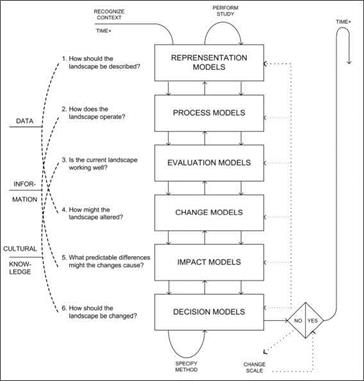Landscapes have been designed for thousands of years by human beings with impact from local to global scale (e. g. climate change, degradation). On the one hand intensive land use had and has a great environmental impact (e. g. fragmentation, biodiversity loss, soil erosion, water contamination) on the other hand specific land use types occurred that are now representative for specific regions (e. g. farmland in the Alps) and that are habitats for endangered species (plants and animals).
While societal and environmental issues are changing six basic questions must be asked in any situation of design (Steinitz, 1990, 2010) (see Fig. 1). Taking this framework into account the technology we are using might help to develop the necessary models and methodologies to manage landscapes in the complex world and to help the decision-makers in a confident way to design sustainable landscapes (Steinitz, 2010).
|
Fig. 1. „Steinitz Framework" (Steinitz, 1990, 2010) |
It is mentioned that there is not one answer which are the best models and what are the spatial-analytic needs for designers or planners (Ervin, 2011). It depends on scale and complexity. The more detailed the planning task is the simpler the models may be and the experience of the planner or designer may be sufficient. For a large scale, the complexity is increasing and appropriate methods must be decided. Two basic strategies exist. The first one is to design the future state and then ask: "By what scenario might it be achieved" (Steinitz, 2010). The second one is to design a scenario and then ask: "In what future might it result?" (Steinitz, 2010).
Steinitz (2010) defined seven basic ways of designing that can be adapted using GIS technologies (at least in part) but that are not dependent upon them. They are accepted and often used in a specific way or in various combinations. They are:
– anticipatory
– participatory
– sequential
– combinatorial
– constraining
– optimizing or
– agent-based.
But there is a great relationship between the factors scale, decision models, process models and the way of designing (Flaxman, 2010, Steinitz, 2010). It is a difference between doing a design at small scale or even larger and larger. Therefore increasingly research is needed focused around the following six themes:
– content-problem seen over varied scales and locations
– decision model and its implementation (e. g. public participation)
– comparative studies of landscape processes (pattern and functions) and its models
– design methods and its applications (e. g. decision support systems, agent-based modeling)
– representation of the results (e. g. visualization techniques, animations, simulations)
– new technologies and its applications (e. g. augmented-reality, mobile devices, GIS on demand, WebGIS) (Steinitz, 2010).




